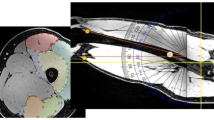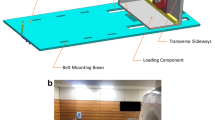Abstract
Patient-specific muscle geometry is not only an interesting clinical tool to evaluate different pathologies and treatments, but also provides an essential input data to more realistic musculoskeletal models. The protocol set up in our study provided the 3D-patient-specific geometry of the 13 main muscles involved in the knee joint motion from a few selected magnetic resonance images (MRIs). The contours of the muscles were identified on five to seven MRI axial slices. A parametric-specific object was then constructed for each muscle and deformed to fit those contours. The 13 muscles were obtained within 1 h, with less than 5% volume error and 5 mm point-surface error (2RMS). From this geometry, muscle volumes and volumic fractions of asymptomatic and anterior cruciate ligament deficient subjects could easily be computed and compared to previous studies. This protocol provides an interesting precision/time trade-off to obtain patient-specific muscular geometry.





Similar content being viewed by others
Notes
Ecole de Technologie Supérieure de Montréal, Centre Hospitalier de l’Université de Montréal, Hôpital du Sacré Cœur de Montréal, Centre de Recherche interdisciplinaire en réadaptation du Montréal métropolitain, Hôpital Maisonneuve-Rosemont de Montréal.
References
Aagaard P, Andersen JL, Dyhre-Poulsen P et al (2001) A mechanism for increased contractile strength of human pennate muscle in response to strength training: changes in muscle architecture. J Physiol 534(Pt 2):613–623. doi:10.1111/j.1469-7793.2001.t01-1-00613.x
Arangio GA, Chen C, Kalady M et al (1997) Thigh muscle size and strength after anterior cruciate ligament reconstruction and rehabilitation. J Orthop Sports Phys Ther 26(5):238–243
Arnold AS, Salinas S, Asakawa DJ et al (2000) Accuracy of muscle moment arms estimated from MRI-based musculoskeletal models of the lower extremity. Comput Aided Surg 5(2):108–119
Asakawa DS, Blemker SS, Rab GT et al (2004) Three-dimensional muscle-tendon geometry after rectus femoris tendon transfer. J Bone Joint Surg Am 86-A(2):348–354
Blemker SS, Asakawa DS, Gold GE et al (2007) Image-based musculoskeletal modeling: applications, advances, and future opportunities. J Magn Reson Imaging 25(2):441–451. doi:10.1002/jmri.20805
Blemker SS, Delp SL (2005) Three-dimensional representation of complex muscle architectures and geometries. Ann Biomed Eng 33(5):661–673. doi:10.1007/s10439-005-1433-7
Cordier F, Magnenat-Thalmann N (1998) Comparison of two techniques for organ reconstruction using visible human dataset. In: Second visible human project conference. National Library of Medicine, Bethesda, 1–2 Oct 1998. http://www.nlm.nih.gov/research/visible//vhpconf98/AUTHORS/CORDIER/FULLTEXT.HTM
Eng CM, Abrams GD, Smallwood LR et al (2007) Muscle geometry affects accuracy of forearm volume determination by magnetic resonance imaging (MRI). J Biomech 40(14):3261–3266. doi:10.1016/j.jbiomech.2007.04.005
Holzbaur KR, Delp SL, Gold GE et al (2007) Moment-generating capacity of upper limb muscles in healthy adults. J Biomech 40(11):2442–2449. doi:10.1016/j.jbiomech.2006.11.013
Holzbaur KR, Murray WM, Gold GE et al (2007) Upper limb muscle volumes in adult subjects. J Biomech 40(4):742–749. doi:10.1016/j.jbiomech.2006.11.011
Hopkins WG (2000) Measures of reliability in sports medicine and science. Sports Med 30(1):1–15. doi:10.2165/00007256-200030010-00001
Jolivet E (2007) Modélisation biomécanique de la hanche dans le risque de fracture du fémur proximal. In: Laboratoire de biomécanique. Ecole Nationale Supérieure d’Arts et Métiers, Paris, p 178
Jolivet E, Daguet E, Pomero V et al (2008) Volumic patient-specific reconstruction of muscular system based on a reduced dataset of medical images. Comput Methods Biomech Biomed Eng 11(3):281–290. doi:10.1080/10255840801959479
Konishi Y, Ikeda K, Nishino A et al (2007) Relationship between quadriceps femoris muscle volume and muscle torque after anterior cruciate ligament repair. Scand J Med Sci Sports 17(6):656–661
Lampe R, Grassl S, Mitternacht J et al (2006) MRT-measurements of muscle volumes of the lower extremities of youths with spastic hemiplegia caused by cerebral palsy. Brain Dev 28(8):500–506. doi:10.1016/j.braindev.2006.02.009
Lloyd DG, Besier TF (2003) An EMG-driven musculoskeletal model to estimate muscle forces and knee joint moments in vivo. J Biomech 36(6):765–776. doi:10.1016/S0021-9290(03)00010-1
Makihara Y, Nishino A, Fukubayashi T et al (2006) Decrease of knee flexion torque in patients with ACL reconstruction: combined analysis of the architecture and function of the knee flexor muscles. Knee Surg Sports Traumatol Arthrosc 14(4):310–317. doi:10.1007/s00167-005-0701-2
Malaiya R, McNee AE, Fry NR et al (2007) The morphology of the medial gastrocnemius in typically developing children and children with spastic hemiplegic cerebral palsy. J Electromyogr Kinesiol 17(6):657–663. doi:10.1016/j.jelekin.2007.02.009
Mikosz RP, Andriacchi TP, Andersson GB (1988) Model analysis of factors influencing the prediction of muscle forces at the knee. J Orthop Res 6(2):205–214. doi:10.1002/jor.1100060207
Mitton D, Landry C, Veron S et al (2000) 3D reconstruction method from biplanar radiography using non-stereocorresponding points and elastic deformable meshes. Med Biol Eng Comput 38(2):133–139. doi:10.1007/BF02344767
Mitulescu A, Semaan I, De Guise JA et al (2001) Validation of the non-stereo corresponding points stereoradiographic 3D reconstruction technique. Med Biol Eng Comput 39(2):152–158. doi:10.1007/BF02344797
Morse CI, Degens H, Jones DA (2007) The validity of estimating quadriceps volume from single MRI cross-sections in young men. Eur J Appl Physiol 100(3):267–274. doi:10.1007/s00421-007-0429-4
Pomero V, Vital JM, Lavaste F et al (2002) Muscular modelling: relationship between postural default and spine overloading. Stud Health Technol Inform 88:321–325
Trochu F (1993) A contouring program based on dual kriging interpolation. Eng Comput 9:160–177. doi:10.1007/BF01206346
Williams GN, Buchanan TS, Barrance PJ et al (2005) Quadriceps weakness, atrophy, and activation failure in predicted noncopers after anterior cruciate ligament injury. Am J Sports Med 33(3):402–407. doi:10.1177/0363546504268042
Williams GN, Snyder-Mackler L, Barrance PJ et al (2005) Quadriceps femoris muscle morphology and function after ACL injury: a differential response in copers versus non-copers. J Biomech 38(4):685–693. doi:10.1016/j.jbiomech.2004.04.004
Zajac FE, Neptune RR, Kautz SA (2003) Biomechanics and muscle coordination of human walking: part II: lessons from dynamical simulations and clinical implications. Gait Posture 17(1):1–17. doi:10.1016/S0966-6362(02)00069-3
Acknowledgments
We thank D. Blain, N. Langlois (Radiological Department, University of Montreal Hospital Centre), and M. Charbonneau (LIO, Montreal) for their help in MRI acquisitions. We also thank Pr J.D. Laredo for helpful comments. This work was funded by the Canada Research Chair in 3D Imaging and Biomedical Engineering, Chaire de recherche en orthopédie Marie-Lou et Yves Cotrel du CHUM, the MENTOR program (ETS-IRSC), and the EGIDE program (Ministère des affaires étrangères français, Ministère des relations internationales québécois).
Conflict of interest statement
None declared.
Author information
Authors and Affiliations
Corresponding authors
Rights and permissions
About this article
Cite this article
Südhoff, I., de Guise, J.A., Nordez, A. et al. 3D-patient-specific geometry of the muscles involved in knee motion from selected MRI images. Med Biol Eng Comput 47, 579–587 (2009). https://doi.org/10.1007/s11517-009-0466-8
Received:
Accepted:
Published:
Issue Date:
DOI: https://doi.org/10.1007/s11517-009-0466-8




